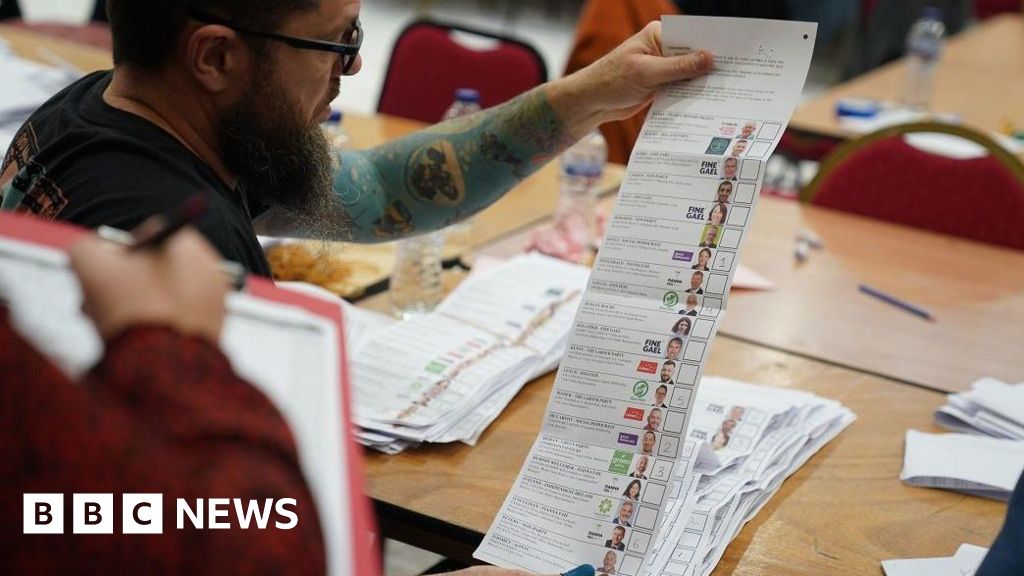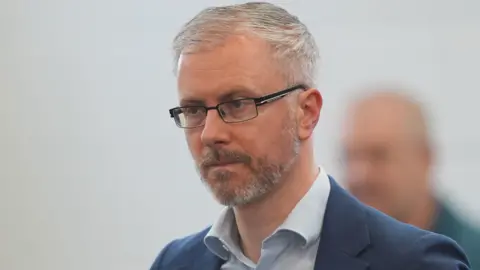Voters have been casting their ballot to choose representatives to serve in the Irish parliament.

www.bbc.com
Tight three-way race in Irish general election, RTÉ exit poll suggests
Kevin Sharkey and Amy Murray
BBC News NI
BBC
An exit poll in the Republic of Ireland suggests that Sinn Féin has 21.1% of first preference votes with Fine Gael having 21%, making the result of the general election too close to call.
The poll indicates Fianna Fáil has 19.5% of first preference votes.
It also suggests that 20% of the second preference votes goes to Fianna Fáil and Fine Gael, with Sinn Féin at 17%.
The exit poll was published at 22:00 local time and was carried out by Ipsos B&A for RTÉ, The Irish Times, TG4 and Trinity College Dublin. It has a margin of error of 1.4%.
In the 2020 Irish general election, Sinn Féin secured 24.53% first preference votes, while Fianna Fáil obtained 22.18% and Fine Gael got 20.86%.
PA Media
Polls closed at 22:00 local time in The Republic of Ireland's election
Friday's poll indicates Green Party first preference support stands at 4%; Labour at 5%; the Social Democrats at 5.8%; People Before Profit-Solidarity at 3.1% and Independents at 12.7%, Independent Ireland 2.2% with others on 1.9%.
The poll is based on 5,018 completed interviews that were carried out immediately after people voted at polling stations in 43 constituencies across the Republic of Ireland.
What happens now?
The results from this poll set the scene for the official counting of votes which starts at 09:00 local time on Saturday and is expected to continue across the weekend.
It is possible that some of the 43 constituencies may not have a final result until the beginning of next week.
Successful candidates are known as Teachtaí Dála (TDs) and there are 174 seats to fill, but the Ceann Comhairle (speaker) is returned automatically.
More than 680 candidates competed for the remaining 173 seats.
The number of seats required for an overall majority is 88 but no single party is fielding enough candidates to win a majority on its own.
The first meeting of the new Dáil (lower house of parliament) is on 18 December but it is unlikely coalition negotiations will have finished by then.
A government will be officially formed when the Dáil passes a vote to install a new taoiseach (Irish prime minister).
Few expect the new government to be in place before 2025.
It took four months after the last general election, in 2020,
before Fianna Fáil, Fine Gael, and the Green Party, reached a deal to form the previous Irish government.
Sinn Féin became the leading opposition party, and both Fianna Fáil and Fine Gael
have both already ruled them out as a potential coalition partner in the event of a similar outcome this election.
The three largest parties are joined in the Dáil by a number of smaller parties and a significant number of independent candidates.
Who are the leading political parties?
Politics in the Republic was traditionally dominated by Fianna Fáil and Fine Gael.
Both parties emerged following a split in nationalist opinion over the 1921 Anglo-Irish Treaty.
Fianna Fáil was once seen as more centrist, Fine Gael as more conservative, but differences have blurred and both are now seen as centre-right parties.
This year’s election is the first major electoral test for the Fine Gael leader and Taoiseach Simon Harris.
He was new to the role in April, when he became the youngest person to lead the Republic of Ireland at 37 after his predecessor Leo Varadkar stepped down.
Sinn Féin is an Irish republican and democratic socialist party and the main opposition party.
Mary Lou McDonald took over leadership of the party in 2018, and since then the Dublin politician has sought to distance her party from criticism about its historic links to IRA violence.
PA Media
Mary Lou McDonald cast her ballot in Dublin on Friday morning
Sinn Féin made significant gains in 2020 and
topped the popular vote, winning 37 seats.
Since then it has
become the largest party across Northern Ireland's councils, as well as in its assembly and at Westminster.
Other parties putting forward candidates for the election include Labour, Social Democrats, PBP-Solidarity, Aontú and the newly-formed Independent Ireland.
Gender divides and transfers
PA Media
Simon Harris brought his family to the polling station in County Wicklow
The exit poll suggests there was a gender divide when it comes to first preference votes.
Figures show 22% of Sinn Féin voters were male, while 20% were female.
The share of male Fine Gael voters in the poll was 20%, while 22% of voters were female.
Fianna Fáil had 19% of male votes, while 20% were female.
In terms of transfers, 39% of Fianna Fáil's second preferences went to a second party candidate, whereas 30% went to a Fine Gael candidate. About 5% of transfers went to Sinn Féin.
The poll also found that about 37% of Fine Gael transfers went to a second candidate, with 32% going to a Fianna Fáil candidate.
'Could be a challenge'
Analysis by BBC News NI's political editor, Enda McClafferty
Exit polls are far from an exact science, but they are a good indicator of where the votes go.
In 2020, it correctly predicted a close battle between Fine Gael, Fianna Fáil and Sinn Féin and in the end, only three seats separated the parties
If the exit poll is right this time, then Sinn Féin will be pleased with its performance.
Coming in slightly ahead of Fine Gael, but short of the almost 25% Sinn Féin secured in 2020.
The party limped into the election campaign of the back of
a series of damaging controversies and poor European and local
council elections in June when it secured just 12% of the vote.
Over the three-week campaign, it managed to recover the lost ground with the promise of bringing change.
But delivering on that pledge could be a challenge if the exit poll is right.
It suggests Fine Gael on 21% and Fianna Fáil on 19.5% could return to the government benches, with the help of two smaller parties and some independents.
While Sinn Féin’s path to power is more challenging as it had hoped to lead a coalition of left-leaning parties, it may struggle to get the numbers with the performance of those smaller parties.
But the true picture will only become clear when all results are in.
Leaders go to the polls
PA Media
Fianna Fáil leader Micheál Martin voted alongside his family in County Cork on Friday
Earlier, Fine Gael leader Simon Harris was the first major party leader to vote.
Harris and his family travelled to Delgany National School in County Wicklow shortly after polls opened at 07:00 local time.
Micheál Martin, the tánaiste (Irish deputy prime minister) and leader of Fianna Fáil, voted with his family at St Anthony's Boys National School in Ballinlough, County Cork.
Sinn Féin's Mary Lou McDonald voted at Deaf Village Ireland on the Navan Road in Dublin.
Things looked a little different for Holly Cairns, leader of the Social Democrats, who gave birth on polling day.
Elsewhere, officials went the extra mile for island inhabitants on polling day.
Presiding Officer Caroline Sharkey and Garda (Irish police officer) Ronan Steede set sail to Gola Island, off the County Donegal coast on the west of Ireland, where 31 registered voters were able to submit their ballots in the living room of one of the islanders.
There will be coverage of the election results on BBC Two NI at 18:00 GMT on Saturday and on BBC One NI on Sunday Politics at 10:00 GMT.


















 )
) 
